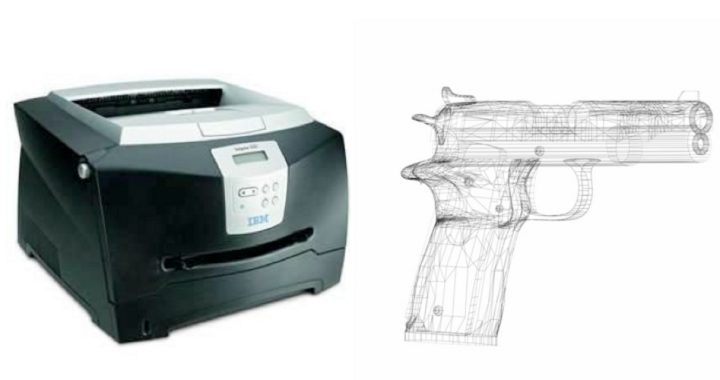
Cody Wilson, a 24-year-old law student at the University of Texas, believes in the free flow of information and created a company to promote it. He went online to raise some capital for his idea, using a crowd funding website, IndieGoGo, which has funded more than 100,000 campaigns in areas such as music, charity, films and small business startups.
But when IndieGoGo got word of the kind of information Wilson wanted to offer for free, they closed his site and refunded the contributors’ money.
His information? Blueprints for making guns at home using 3-D printers.
Wilson refused to be deterred and created an Internet “collective” called Defense Distributed, where Wilson, in a seven-minute video, explains what he’s up to:
We want to show this principle: that a handgun is printable. You don’t need to be able to put 200 rounds through it, it only has to fire once.
But even if the design is a little unworkable, it doesn’t matter, as long as it has that guarantee of lethality.
So far his video has raised more than $20,000 from contributors who like his idea. Says Wilson:
They wanted to get this done. I think it shows they really believe in a future where a gun is unalienable … a kind of faith in American individualism, the sovereignty of the individual.
Calling his project the Wiki Weapon, he wants to develop software that would create a working weapon using 3-D technology. He doesn’t want to make weapons, or sell them. He just wants to help develop the software technology for others to do so, if they wish. For free.
And so Wilson is creating a contest for enthusiasts and supporters of the idea to develop software which he will use to create a weapon, test it, see if it works, and then offer that software for free on the Internet.
Wilson is also a libertarian and thinks his efforts will promote freedom through this technology. It’s “less about a gun…than about democratizing manufacturing technology,” calling it an “experiment with Enlightenment ideas…to literally materialize freedom.” He told the New York Daily News:
We’re not trying to be a business. We want to give it away. The goal is to have workable designs that anyone can use and modify as they please.
This is normal, typical American entrepreneurialism, according to Dudley Brown, executive vice-president of the National Association for Gun Rights:
People have been making firearms at home since before America was a country. And not only does it not make it dangerous, it makes America safer. It’s where most of the innovation came from.
John Moses Browning built guns out of his basement. We’re still using them.
And when Brown was asked if such freedom made him nervous, he responded: “Afraid of it? Their ability to do that is the very goal.”
Wilson isn’t the first to attempt to use software to build a weapon at home. Michael Guslick, an engineer with the moniker “HaveBlue”, has built the lower receiver (the workings of the weapon) using his 3-D printer and then installed the rest using parts available at gun stores or online. He successfully fired 200 rounds with the weapon without mishap or misfires.
It’s no big deal, according to Guslick: “Firearms manufacturers have been doing [this] for prototyping and testing for many years, and I’m certain that many hobbyists have used 3-D printed gun parts as well.”
Not everyone is so supportive. After an interview with the Bureau of Alcohol, Tobacco, Firearms and Explosives (BATFE), Wilson was informed that if he actually creates a weapon at home, he’ll have to have a federal license to do so. And so he is getting one.
Others are far less happy. Writing in the New York Times, Nick Bilton exposed his anti-gun mentality by suggesting that
It won’t be long before a felon, unable to buy a gun legally, can print one at home. Teenagers could make them in their bedroom while their parents think they are “playing on their computer.” I’m talking about a fully functional gun, where the schematic is downloaded free from the Internet and built on a 3-D printer, all with the click of a button.
Hit print, walk away, and a few hours later, you have a firearm. There are no background checks. No age limits. No serial numbers etched on the barrel or sales receipts to track the gun.
According to Bilton, the danger is even worse: 3-D printers will be able to replicate themselves, and there’s nothing the BATFE can do about it:
Monitoring whether people make their own guns on a 3-D printer is going to be impossible, barring sticking an A.T.F. agent in every home. It’s also hopeless to try to build a technology into these printers that prevents people from printing a gun. One project mentioned in Mr. Wilson’s video, called the RepRap printer, will be capable of replicating itself by printing other 3-D printers.
Naturally the advance of this technology makes other people nervous as well. The Guardian imagined “an America in which anyone can download and print a gun in their own home. They wouldn’t need a license, a background check, or much technical knowledge, just a 3D printer.”
This freedom also disturbs the inevitable Brady anti-gun crowd. Daniel Gross, president of the Brady Campaign to Prevent Gun Violence, said:
This becomes scary when you consider the fact that it would be yet another opportunity for people to evade background checks and get a gun.
Wilson is right. The new 3-D technology “materializes freedom.”
Photo: 3-D gun: Thinkstock



